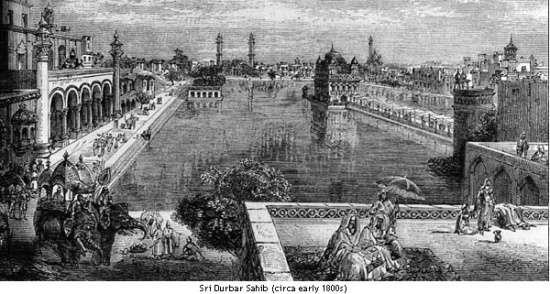Sevapanthi: Difference between revisions
No edit summary |
Allenwalla (talk | contribs) m (changed -> Thetrefore term- to - The term therefore- hope correct/enlarge excellent old engraving!!!!) |
||
| (One intermediate revision by one other user not shown) | |||
| Line 1: | Line 1: | ||
Sevapanthi is a conjunction of two words:Seva which means selfless service | [[Image:Sri_darbar_sahib_around_1800.jpg|550px|right]] | ||
'''Sevapanthi''' is a conjunction of two words: | |||
*Seva which means selfless service | |||
*Panthi where Panth lit. means widened road; or here meaning - path of. | |||
The term therefore can be defined as - those who take the path of selfless service. | |||
Sevapanthi centres are usually termed one of the following: | |||
*Tikana | |||
*Ashram | |||
*Dera | |||
*Dharamsala | |||
Historically, Tikana was the preferred term for a sevapanthi centre. | |||
Going back 200 years Sri | |||
Going back 200 years Sri [[Darbar Sahib]] was encircled by numerous bungae (institutes of learning) run by sevapanthis. Bab Gyani Gian Singh Nirmala in his '' 'Twarikh Sri Amritsar' '' lists all bungae existant at that time in much greater detail. | |||
Not only were sevapanthis humanitarians and scholars, but also calligraphers. Baba Rangji was famed for his Birs of the ''Guru Granth Sahib''. A further living testimony of this heritage is [[Adhanshahi]] ink, recognized as an excellant type of ink made and used by sevapanthis. | |||
===External Link=== | ===External Link=== | ||
Latest revision as of 14:53, 25 January 2008
Sevapanthi is a conjunction of two words:
- Seva which means selfless service
- Panthi where Panth lit. means widened road; or here meaning - path of.
The term therefore can be defined as - those who take the path of selfless service.
Sevapanthi centres are usually termed one of the following:
- Tikana
- Ashram
- Dera
- Dharamsala
Historically, Tikana was the preferred term for a sevapanthi centre.
Going back 200 years Sri Darbar Sahib was encircled by numerous bungae (institutes of learning) run by sevapanthis. Bab Gyani Gian Singh Nirmala in his 'Twarikh Sri Amritsar' lists all bungae existant at that time in much greater detail.
Not only were sevapanthis humanitarians and scholars, but also calligraphers. Baba Rangji was famed for his Birs of the Guru Granth Sahib. A further living testimony of this heritage is Adhanshahi ink, recognized as an excellant type of ink made and used by sevapanthis.

